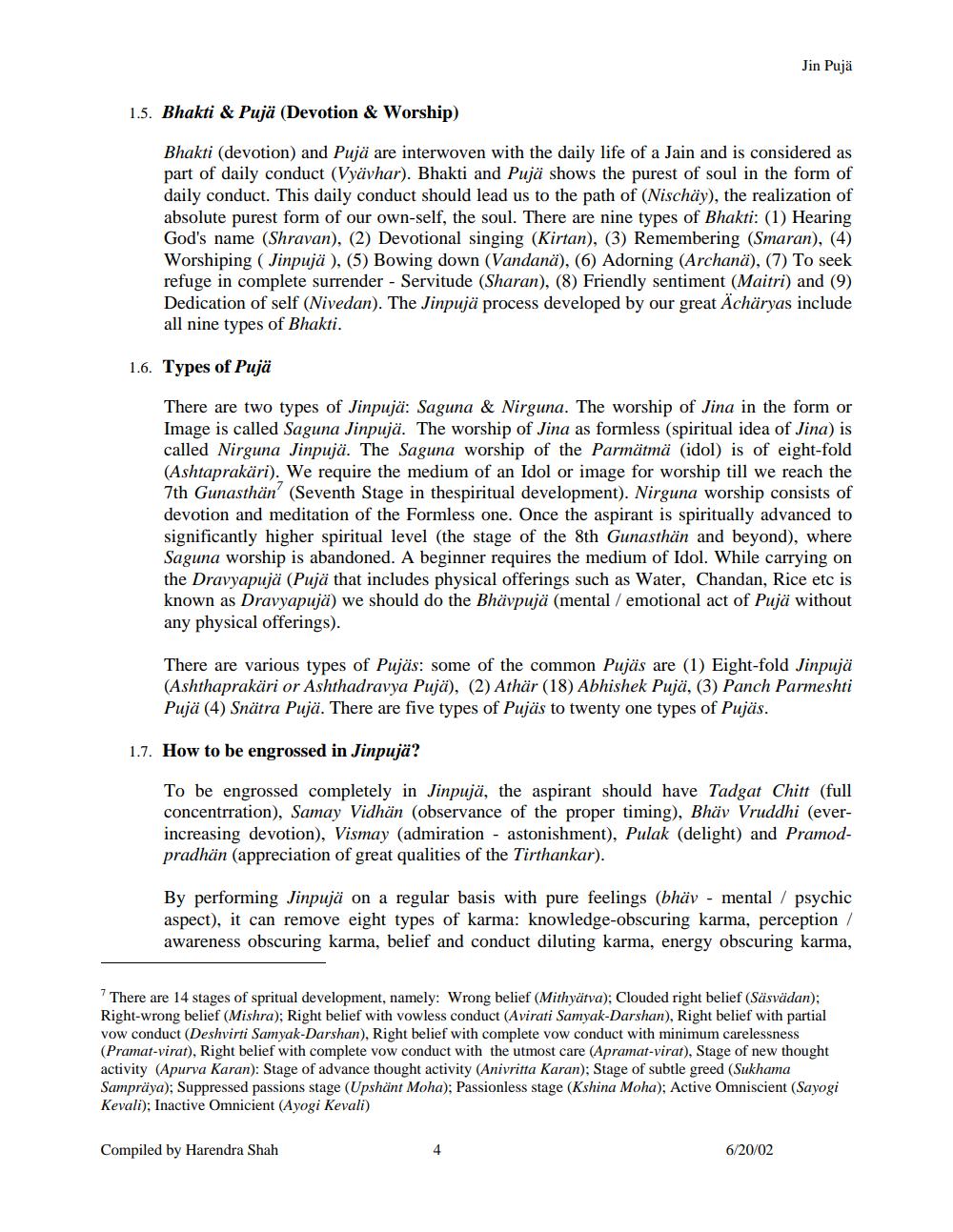________________
Jin Pujä
1.5. Bhakti & Pujä (Devotion & Worship)
Bhakti (devotion) and Pujä are interwoven with the daily life of a Jain and is considered as part of daily conduct (Vyävhar). Bhakti and Pujä shows the purest of soul in the form of daily conduct. This daily conduct should lead us to the path of (Nischäy), the realization of absolute purest form of our own-self, the soul. There are nine types of Bhakti: (1) Hearing God's name (Shravan), (2) Devotional singing (Kirtan), (3) Remembering (Smaran), (4) Worshiping (Jinpujä ), (5) Bowing down (Vandanä), (6) Adorning (Archanä). (7) To seek refuge in complete surrender - Servitude (Sharan), (8) Friendly sentiment (Maitri) and (9) Dedication of self (Nivedan). The Jinpujä process developed by our great Ächäryas include all nine types of Bhakti.
1.6. Types of Pujä
There are two types of Jinpujä: Saguna & Nirguna. The worship of Jina in the form or Image is called Saguna Jinpujä. The worship of Jina as formless (spiritual idea of Jina) is called Nirguna Jinpujä. The Saguna worship of the Parmätmä (idol) is of eight-fold (Ashtaprakäri). We require the medium of an Idol or image for worship till we reach the 7th Gunasthän (Seventh Stage in thespiritual development). Nirguna worship consists of devotion and meditation of the Formless one. Once the aspirant is spiritually advanced to significantly higher spiritual level (the stage of the 8th Gunasthän and beyond), where Saguna worship is abandoned. A beginner requires the medium of Idol. While carrying on the Dravyapujä (Pujä that includes physical offerings such as Water, Chandan, Rice etc is known as Dravyapujä) we should do the Bhävpujä (mental / emotional act of Pujä without any physical offerings).
There are various types of Pujäs: some of the common Pujäs are (1) Eight-fold Jinpujä (Ashthaprakäri or Ashthadravya Pujä), (2) Athär (18) Abhishek Pujä, (3) Panch Parmeshti Pujä (4) Snätra Pujä. There are five types of Pujäs to twenty one types of Pujäs.
1.7. How to be engrossed in Jinpujä?
To be engrossed completely in Jinpujä, the aspirant should have Tadgat Chitt (full concentration), Samay Vidhän (observance of the proper timing), Bhäv Vruddhi (everincreasing devotion), Vismay (admiration - astonishment), Pulak (delight) and Pramodpradhän (appreciation of great qualities of the Tirthankar).
By performing Jinpujä on a regular basis with pure feelings (bhäv - mental / psychic aspect), it can remove eight types of karma: knowledge-obscuring karma, perception / awareness obscuring karma, belief and conduct diluting karma, energy obscuring karma,
There are 14 stages of spritual development, namely: Wrong belief (Mithyätva): Clouded right belief (Säsvädan): Right-wrong belief (Mishra); Right belief with vowless conduct (Avirati Samyak-Darshan), Right belief with partial vow conduct (Deshvirti Samyak-Darshan), Right belief with complete vow conduct with minimum carelessness (Pramat-virat), Right belief with complete vow conduct with the utmost care (Apramat-virat), Stage of new thought activity (Apurva Karan): Stage of advance thought activity (Anivritta Karan); Stage of subtle greed (Sukhama Sampräya); Suppressed passions stage (Upshänt Moha); Passionless stage (Kshina Moha); Active Omniscient (Sayogi Kevali); Inactive Omnicient (Ayogi Kevali)
Compiled by Harendra Shah
6/20/02




